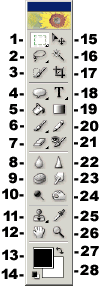Photoshop Elements 2 Clone Stamp
Photoshop Elements 2 Clone Stamp |
|
|
|
|
| Used for painting with copied image data |
|
  |
With the clone stamp tool (formerly known as the rubber stamp tool), you can copy, or clone copies of a portion of an image and paint them onto any other part of the image. The size of the area copied depends on the brush size you select from the brushes pop-up menu on the tool’s options bar. How the copy merges with the new area is determined by the choices you make on the options bar [see below]. Hold down the Alt key while clicking to pick up, or copy the image data you want to transfer. Then move the pointer to where you want to apply that data and click, or click and drag. A cross-hair will appear to indicate where you are copying from. When you start painting, the cross-hair will be at the spot where you Alt-clicked. Depending on whether you chose Aligned in the options bar, the cross-hair will parallel your strokes, or return to that original spot after each release of the mouse button. Be aware that if you have added adjustment layers or have a stack of layers with a variety of blend modes above the layer that you want to clone to, your clones will be all wrong. You need to turn off adjustment layers or blends other than Normal at lowered opacity (turn off visibility by clicking the eyeball icon at the left end of those layers) while your are doing your cloning. Turn them back on once you are done. Note – if your Alt key does not appear to be working in Elements, you may have another program running in the background that has taken over that key. GuruNet (Atomica) and FlySwat are two such applications. Uninstall them, or reassign the hot key in those programs to regain use of the Alt key in Elements. You can use the clone, and pattern stamp tools to copy data between different images, as well as within the same image. A shortcut to change brush sizes while using any of the paint tools, including the clone stamp tool, is to press the left bracket [ to decrease brush size, or the right bracket ] to increase brush size. The keyboard shortcut for the clone and pattern stamp tools is the letter S.
|
|
The illustration below, is the clone stamp tool’s options bar (split in two because it’s so long). The stamp icon on the left is the clone stamp. The one on the right (with the little checkerboard next to it) is the pattern stamp. To choose a brush size and type, click on the brush stroke thumbnail. A pop-up palette of available brushes will appear. For more information on brushes, please see the Brushes page. The box titled Mode, and showing Normal is a drop down menu of all the blend modes. The Opacity setting determines how transparent the copied image portions will be when reapplied. A setting of 100 % is completely opaque. 0 % is completely transparent. Type a value in the text box, or access a slider by clicking on the arrow at the right side of the box. If you have Aligned checked, your clones will be applied as if you were working with a copy of the image that has been displaced the distance of your first stroke after Alt-clicking. All subsequent strokes (prior to another Alt-click) will fill in the copied image relative to that first stroke. When you do not have Aligned checked, all (separate) strokes after an Alt-click will apply from the single spot that you Alt-clicked. Each time you end one stroke and make a new one, the new one will use the same starting spot (your Alt-click location). Thus you can repeatedly apply the same image data (the Alt-click location) to different spots. Note that double-clicking when you are Alt-clicking will turn Aligned on if you have it off. I do this all the time by mistake (I use a stylus). This can be a real nuisance since it makes a mess if you think you have it off when it’s on. I want it to be off (not aligned) and stay off. Use All Layers is a valuable option that you should take advantage of whenever possible. When it is turned on, you can add an empty layer above your image and do your cloning on that layer. This allows you to clone without changing your base image; you can use the eraser to correct mistakes, or delete the entire layer if you don’t like what you have done. If you do not have this option checked, you must clone on the image itself, and clone/sample data will be copied only from that layer. Right-clicking on the image when the clone tool has been selected in the toolbox will cause the brushes pop-up palette to appear next to your cursor. Press Enter or click on your document’s blue title bar to close the pop-up palette. |
|
|
|
|
|
If you have doodled with a tool’s options and want to get back to the default settings, click that tool’s icon at the far left end of its options bar. Choose either Reset Tool to reset only the current tool, or Reset All Tools to restore default settings to every tool. Please note that all descriptions, and illustrations featured refer to files which are in Photoshop’s .psd format, and which are in RGB color mode. Other file formats, and color modes may generate different options. Some Photoshop features are not available for images not in .psd format, or RGB color mode. To find what color mode your image is in, choose Image > Mode. |
|


Comments